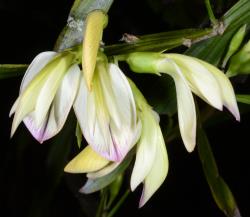- Taxon
- Gallery
Upright and spreading shrub, up to 2-4 × 2—4 m. Branches 50-100 mm diameter, stout, ascending or spreading. Cladodes (130-)180-380 × (5—)8-12 mm, linear, striate, compressed, yellow-green or green, glabrous, apex obtuse; leaf nodes 7—16. Leaves 1—3-foliolate, present on seedlings and rarely on adult plants, terminal leaflet larger; lamina 6-23 × 5-15 mm, elliptic, obovate to broad-elliptic, fleshy, green with yellow marking on proximal part, terminal leaflet larger than lateral leaflets, adaxial surface glabrous, abaxial surface with scattered hairs, apex refuse, base cuneate; petiole 5—15 mm long, with scattered hairs; petiolule 1- 5 mm long, with scattered hairs. Leaves on cladodes reduced to scales, < 1 mm long, broad-triangular, abaxial surface with scattered hairs and becoming glabrous with age, apex subacute. Stipules c. 1.5 × c. 1 mm, free, broad-triangular, sometimes with a second pair of smaller denticles, adaxial surface glabrous, abaxial surface with scattered hairs, apex subacute, margin with scattered hairs. Inflorescence a raceme, often in fascicles of 3 or 4 per node, each with (1-)2-4(-5) flowers. Peduncle 1-6 mm long, hairy, green. Bracts 1—1.4 × 0.8-1.5 mm, narrowtriangular to broad-triangular, abaxial surface and margin hairy and becoming sparsely hairy or glabrous with age, apex subacute to obtuse. Pedicel 4— 8 mm long, hairy, pale green. Bracteoles 0.4-0.6 × c. 0.2 mm, narrow-triangular to linear, on pedicel, abaxial surface glabrous, or hairy and becoming glabrous with age, apex subacute, margin hairy. Calyx 8—9 × 4.7-5.5 mm, campanulate, green, outer surface glabrous. Calyx lobes triangular, green and usually flushed red, inner surface and margin hairy, appressed to corolla, apex acute. Bud green, becoming yellow-green at maturity. Standard 18-22 × 11— 13.5 mm, ovate, patent, keeled, margins incurved, positioned in proximal part of keel, apex subacute or often weakly retuse, yellow to pale yellow with central part of inner surface and marginal veins maroon-red; claw 8-9 mm long, green. Wings 20- 22 × 4-4.5 mm, oblong, falcate, shorter than keel, yellow to pale yellow, apex subacute, margin with a few scattered hairs; auricle 3.5-4.5 × 1.5—2 mm, oblong, pale yellow; claw 5.5-6 mm long, pale green. Keel (Fig. 2F) 25—27 × 7-8 mm, apex narrow and acute, yellow, distal part of inner surface maroon- red; auricle c. 1.5 × c. 1.5 mm, triangular, yellow- green, apex rounded; claw 9—10 mm long, pale green. Stamens 28—30 mm long; dorsal filaments connate for c. Vt of length, outer stamens free for 6— 11 mm. Pistil c. 32-33 mm long, exserted beyond stamens, glabrous except for a small tuft of hairs on inner surface below stigma; ovules (12—) 14-16(-17). Pods 23-34 × 6-12 mm, oblong to oblanceolate, laterally compressed, spreading, light to dark brown, valves dehiscent; beak 2-4 mm long, in central apical position, stout, pungent-tipped. Seeds 3-5 × 2 - 3 mm, reniform to oblong-reniform, (5—)8—15 per pod, dull red to orange-red and sometimes with black mottling, often remaining attached to funicle. Chromosome number 2n = 32 (Slade 1953). FL May-Nov, FT Oct-May.
[Reproduced from Heenan (1996, New Zealand J. Bot. 34: 157-177) with permission from The Royal Society of New Zealand.]




